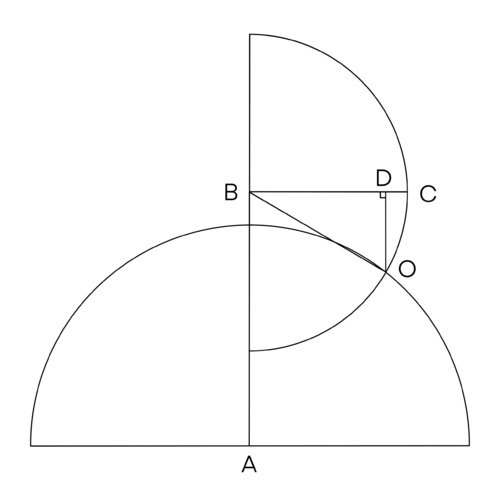Difference between revisions of "2003 AMC 12B Problems/Problem 21"
Isabelchen (talk | contribs) m (→Solution 2) |
Isabelchen (talk | contribs) m (→Solution 2 (Analytic Geometry)) |
||
| Line 27: | Line 27: | ||
Note that the possible points of <math>C</math> create a semi-circle of radius <math>5</math> and center <math>B</math>. The area where <math>AC < 7</math> is enclosed by a circle of radius <math>7</math> and center <math>A</math>. The probability that <math>AC < 7</math> is <math>\frac{\angle ABO}{180 ^\circ}</math>. | Note that the possible points of <math>C</math> create a semi-circle of radius <math>5</math> and center <math>B</math>. The area where <math>AC < 7</math> is enclosed by a circle of radius <math>7</math> and center <math>A</math>. The probability that <math>AC < 7</math> is <math>\frac{\angle ABO}{180 ^\circ}</math>. | ||
| − | The function of <math>\odot B | + | The function of <math>\odot B</math> is <math>x^2 + y^2 = 25</math>, the function of <math>\odot A</math> is <math>x^2 + (y+8)^2 = 49</math>. |
| − | <math>O</math> is the point that satisfies both functions | + | <math>O</math> is the point that satisfies both functions: <math>\begin{cases} x^2 + y^2 = 25 \\ x^2 + (y+8)^2 = 49 \end{cases}</math> |
<math>x^2 + (y+8)^2 - x^2 - y^2 = 49 - 25</math>, <math>64 + 16y =24</math>, <math>y = - \frac52</math>, <math>x = \frac{5 \sqrt{3}}{2}</math>, <math>O = (\frac{5 \sqrt{3}}{2}, - \frac52)</math> | <math>x^2 + (y+8)^2 - x^2 - y^2 = 49 - 25</math>, <math>64 + 16y =24</math>, <math>y = - \frac52</math>, <math>x = \frac{5 \sqrt{3}}{2}</math>, <math>O = (\frac{5 \sqrt{3}}{2}, - \frac52)</math> | ||
Revision as of 08:36, 1 September 2022
Problem
An object moves ![]() cm in a straight line from
cm in a straight line from ![]() to
to ![]() , turns at an angle
, turns at an angle ![]() , measured in radians and chosen at random from the interval
, measured in radians and chosen at random from the interval ![]() , and moves
, and moves ![]() cm in a straight line to
cm in a straight line to ![]() . What is the probability that
. What is the probability that ![]() ?
?
![]()
Solution 1 (Trigonometry)
By the Law of Cosines,

It follows that ![]() , and the probability is
, and the probability is ![]() .
.
Solution 2 (Analytic Geometry)
![]() , let the object turn clockwise.
, let the object turn clockwise.
Let ![]() ,
, ![]() .
.
Note that the possible points of ![]() create a semi-circle of radius
create a semi-circle of radius ![]() and center
and center ![]() . The area where
. The area where ![]() is enclosed by a circle of radius
is enclosed by a circle of radius ![]() and center
and center ![]() . The probability that
. The probability that ![]() is
is ![]() .
.
The function of ![]() is
is ![]() , the function of
, the function of ![]() is
is ![]() .
.
![]() is the point that satisfies both functions:
is the point that satisfies both functions: 
![]() ,
, ![]() ,
, ![]() ,
, ![]() ,
, ![]()
Note that ![]() is a
is a ![]() triangle, as
triangle, as ![]() ,
, ![]() ,
, ![]() . As a result
. As a result ![]() ,
, ![]() .
.
Therefore the probability that ![]() is
is ![]()
See also
| 2003 AMC 12B (Problems • Answer Key • Resources) | |
| Preceded by Problem 20 |
Followed by Problem 22 |
| 1 • 2 • 3 • 4 • 5 • 6 • 7 • 8 • 9 • 10 • 11 • 12 • 13 • 14 • 15 • 16 • 17 • 18 • 19 • 20 • 21 • 22 • 23 • 24 • 25 | |
| All AMC 12 Problems and Solutions | |
The problems on this page are copyrighted by the Mathematical Association of America's American Mathematics Competitions. 










